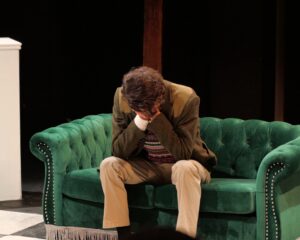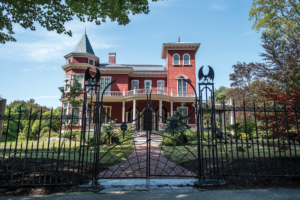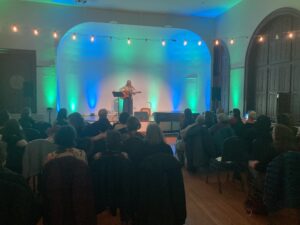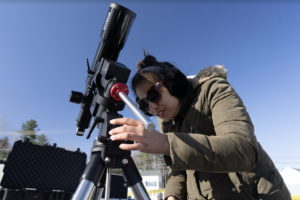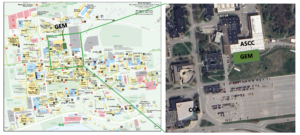On a night with clear skies and stars shining their brightest, a grandpa shows his grandson the little dipper. That grandson knew, from that moment forward, he would be looking at the stars forever.
The Versant Power Astronomy Center & Jordan Planetarium is an astronomy, education and outreach facility teaching people since 1954. Shawn Laatsch is the director of the astronomy center. “We serve, of course, K-12, schools, university classes and the general public,” said Laatsch.
Not only does the center offer services to a variety of people, but it also offers a wide range of programs. “We also do a variety of programming beyond astronomy. I tell folks, for instance, this afternoon, we have the Bangor Symphony Orchestra, who will be here with a project for their lunch and learn. We’ve done live theater performances in the Planetarium. So just a whole variety of different activities that we can use,” said Laatsch.
First-year political science student Forest Goodwin was in attendance for the planetarium’s Dark Side of the Moon show. “I would describe it as a psychedelic experience; travel around space, time, and there was lots of light,” said Goodwin.
Goodwin believes The Wall is one of the best albums of all time. “You can visualize the album in your head, and it’s not telling a random story, it’s personal to Roger Watters, and you can really see that in the show,” said Goodwin.
Choosing the programming for the auditorium is a job that usually falls on the director, who must attend conferences to preview the content and decide if it’s right for the planetarium.
Laatsch grew up in Wisconsin and was shown the stars by his grandfather.
“I kind of got excited as a child; my grandfather showed me the Big Dipper and the Little Dipper, which were the only constellations he knew. Then, I visited a planetarium in second grade, and that got me really excited. When I got back to that facility, as a high school student, I asked the person running it if he could teach me how to do it, and that got me started,” said Laatsch.
Since starting, Laatsch has been facilitating astronomy-related education outreach for about 40 years. “I was an officer in the International Planetarium Society for about 25 years. So, I’ve had a chance to travel to a variety of different places. I’ve been a guest speaker in numerous countries,” said Laatsch.
He has also worked with NASA. “I am what they call a NASA Solar System ambassador—that is a volunteer role. They choose certain people to do astronomy, education and outreach,” said Laatsch.
Laatsch’s most recent work with NASA is a project on the eclipse, which will occur in April. This eclipse is special; it’s the first solar eclipse Maine will be able to see in totality since 1963.
“I currently am working on a project for the upcoming eclipse. It’s a project called Cate 2024, which stands for Continental American Telescopic Eclipse. I’m the Northeast Regional Coordinator for that group. We’ll be setting up 35 stations from Texas through Maine in the path of totality, to measure the polarity data of the corona,” said Laatsch.
If you miss this total eclipse, you won’t be able to see another until 2079. “You know, most people get to see partial solar eclipses. But totality is a completely different thing. I often tell folks, the difference between seeing a partial eclipse and a total is like the difference between seeing a lightning bug and getting hit by lightning,” said Laatsch.
Joe Lazaro is a first-year English student at the University of Maine.


